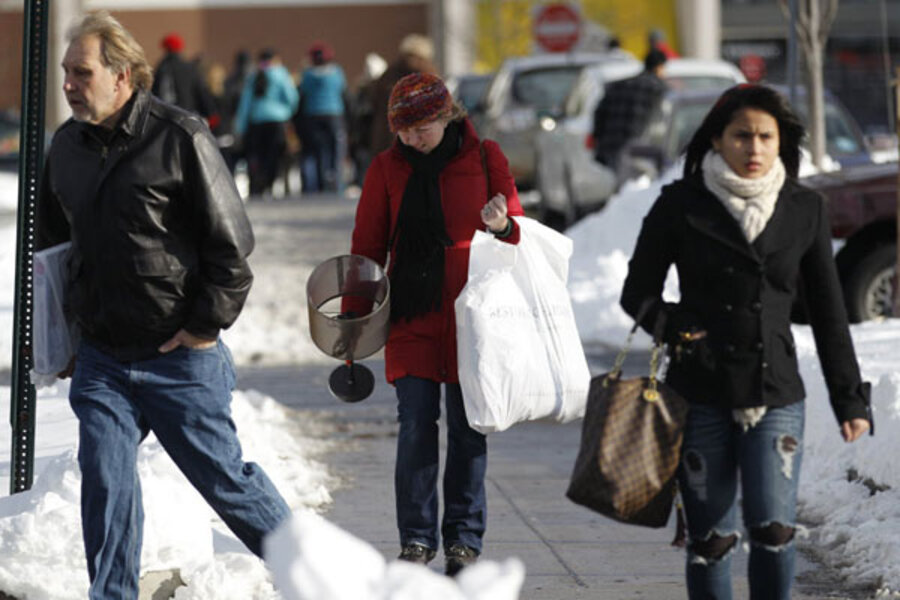Strong holiday season for retail bolstered by online shopping
Loading...
| Chicago
Shoppers returned to the malls and cyberspace to spend more money this holiday season, at the same time both consumer confidence and housing prices dropped. Aggressive discounting combined with a pent-up demand to spend may be driving retail sales, analysts suggest, but consumers may be cautious about how much they’re willing to keep purchasing once the new year begins.
Consumers spent 5.5 percent more between Nov. 5 and Dec. 24 compared with the same period last year, according to MasterCard Advisors’ SpendingPulse, which tracks all retail sales except automotive.
Online shopping had the greatest growth, at 15.4 percent – most likely because of more incentives such as free shipping and group-coupon promotions. Most major retailers responded to fears about a drop in sales this holiday season by offering generous online discounts early on, which helped drive up sales, says Lynn Franco, director of the Consumer Research Center at the Conference Board, a not-for-profit organization in New York.
“[Retailers] really positioned themselves well, and consumers took advantage of that. It became a chicken-and-egg game as consumers have come to expect discounts and waited to get better deals online,” Ms. Franco says.
Apparel sales grew 11.2 percent, a big turnaround from 2009, when sales dropped 0.4 percent. Menswear grew 10.5 percent, while women’s apparel grew 5.6 percent.
Spending increased the weekend closest to Christmas, says ShopperTrak, a retail data tracking firm based in Chicago. Sales topped $18.83 billion the weekend of Dec. 17-19, a 5.5 percent increase from the previous year.
According to another report, sales at chain stores increased 4.5 percent in the week that ended Dec. 25, compared with the same period in 2009. The International Council of Shopping Centers and Goldman Sachs released that report Tuesday. The growth was the highest seen since April, the report said.
Still, it remains to be seen whether the rise in consumer spending is temporary or will continue into 2011.
Consumer confidence is down, the Conference Board says. Its index of consumer confidence, based on a sample of 5,000 US households, dropped to 52.5 in December from 54.3 in November, the organization reported Tuesday.
Consumer perception over the labor markets also worsened, according to the index. Those saying jobs are hard to get rose to 46.8 percent from 46.3 percent in November. Those saying jobs are plentiful dropped to 3.9 percent from 4.3 percent.
Franco, however, is not alarmed at the slight number shifts and instead characterizes the findings as showing a “sideways” movement in confidence.
“There’s nothing indicating the economy is suddenly heading into more negative territory,” she says. “We do expect consumer spending to continue, but at a moderate pace.”
What may be preventing the floodgate release of spending is the continued devaluing of US homes. In a report released Tuesday by Standard & Poor’s/Case-Shiller, a home-value index dropped 0.8 percent in October – the fourth consecutive monthly decline and the greatest year-to-year decline since December 2009.
Eighteen of 20 cities surveyed showed a price decrease in October. Only Denver and Washington posted gains. The housing market will continue as the weak link in the economy in 2011, which will have a trickledown effect on how much consumers are willing to spend, economists say.
Housing prices will “remain in negative territory for several more months,” Dean Maki, chief US economist at Barclays Capital in New York, told Bloomberg News Tuesday. Mr. Maki forecasts a decline of 1.3 percent in housing prices this year, saying, “None of the recent data suggest a substantial pickup.”
One reason that holiday spending trends may not be an accurate snapshot of overall consumer spending is that Christmas is typically a time when consumers will spend whether or not it’s not good for their pocketbooks.
“Americans are great spenders but lousy savers,” says Gail Cunningham, a spokeswoman for the National Foundation for Credit Counseling, a nonprofit advocacy organization in Silver Spring, Md. Ms. Cunningham says it is likely that consumers spent more this season because of “frugal fatigue” after trying hard to cut down their debt all year – not necessarily because of a rebound in financial health.
“Some people think they deserve to spend,” she says. “But when the bills start arriving in the mailbox in January, they may wonder, ‘What was I thinking?’ ”





